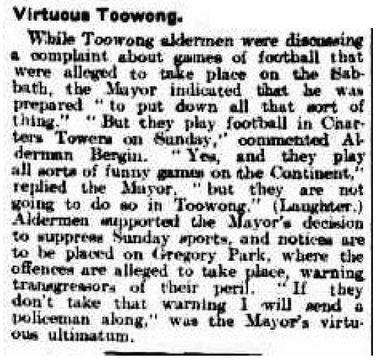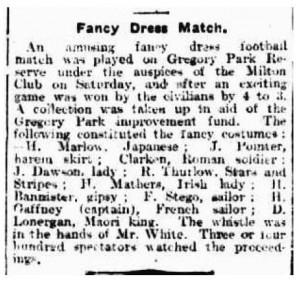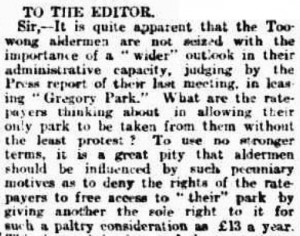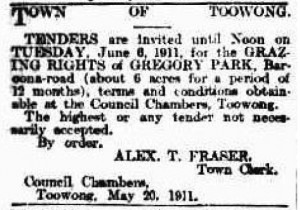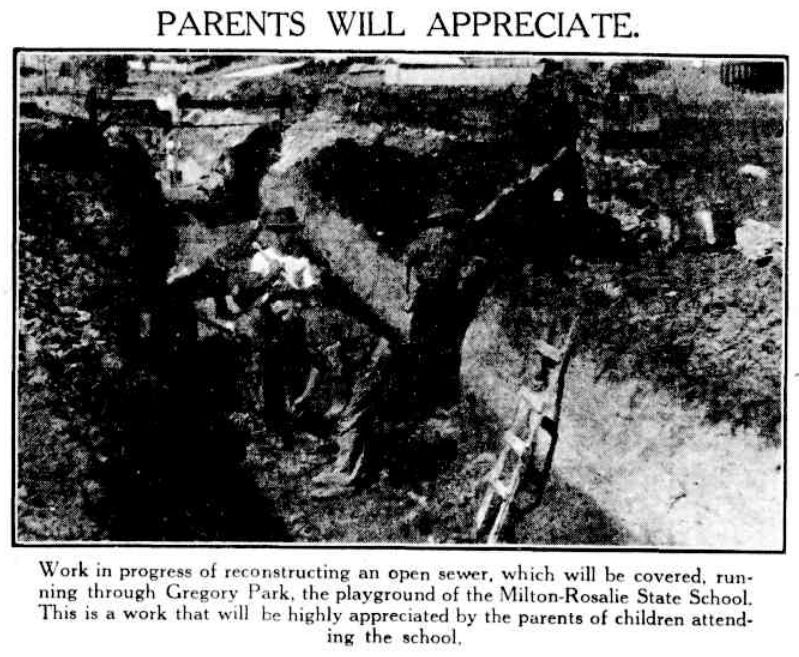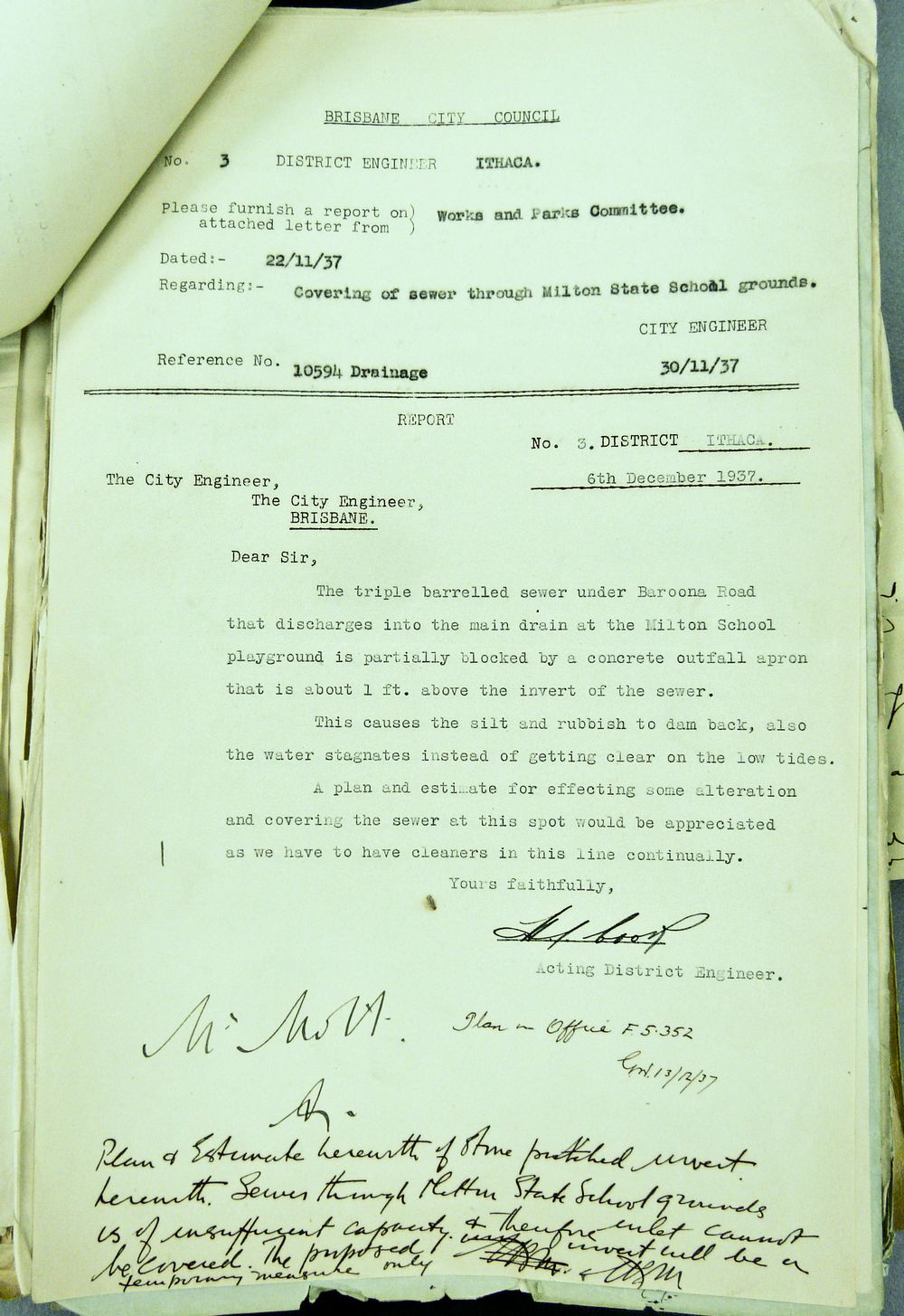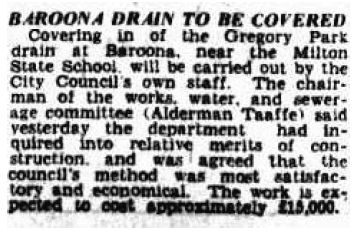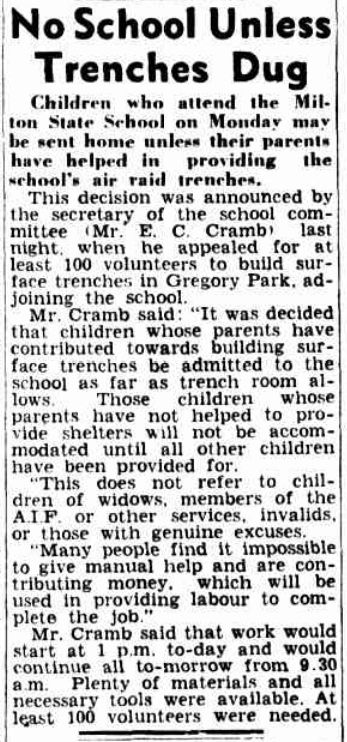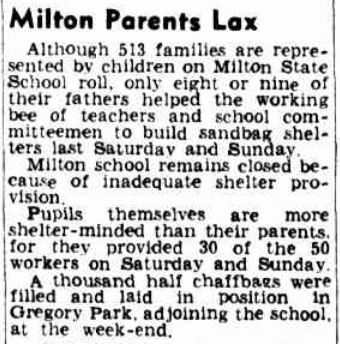From Red Jacket Swamp to Rosalie’s playground:
The story of Gregory Park
Page 1 – Page 2 – Page 3 – Page 4 – Page 5 – Contents
3. Gregory Park comes of age (1904 – 1945)
A reserve for recreation (1904 – 1916)
For many years, the formal designation of Red Jacket Swamp as a ‘recreation reserve’ was at best ironic, and at worst insulting to the residents and school children who had to put up with its putrid condition. But with the new drain finally built, and with at least some parts of the swamp filled in, the newly named Gregory Reserve could start to live up to its promise as a place of recreation.
Some further filling of the reserve probably occurred in the years following 1903, because by July 1906 the ground was fit to host district soccer games, and then cricket in the summer. Or at least, it was when the weather was dry, for the return of Gregory’s Mud Hole was only ever as far away as the next shower of rain. In September 1906 when the Milton Football Club played Toowoomba (who beat the locals 4–2), it was reported that “The state of the ground was not conducive to good football”.1 Nonetheless, the park would soon boast some impressive facilities. A concrete cricket pitch was installed in time for the 1906-07 season,2 and at the meeting of the Milton and Dinmore football clubs on 27 April 1907 “It was noted with satisfaction that the Milton Club used goal nets for perhaps the first time in Brisbane” (again, the home team lost, this time going down 4–1).3
Very quickly, the park also became a popular venue for social sports — a little too popular, in fact, for some of the more pious members of the community. In 1906 the Toowong Council received complaints from residents about football being played on Sabbath.4 Similar complaints were received in 1922 (though whether it was the same residents making them is not clear!).5 The Mayors in both cases took a hard line, even if not all of their aldermen agreed.
Let’s make another committee (1909-1924)
By the early 1900s Gregory Park had become an important local sporting and social venue, but there was a long way to go before the park could truly take pride of place in the neighbourhood, and shake off once and for all the ghost of Red Jacket Swamp. The open drain, which the ratepayers of the 1890s had so strongly opposed, remained uncovered, and much of the ground was still swampy, filthy and prone to flooding.
In May 1909 a public meeting, presided over by the Mayor of Toowong, Alderman R. J. Cottell, was convened “to deal with the question of improving the lower parts of Gregory Park Reserve . . . which were at the present time a menace to the good health of the neighbourhood and an eyesore to visitors”.6 The meeting resolved to raise subscriptions to fund the work, and to establish a Gregory Park Improvement Committee to make it all happen. The Toowoong Council agreed to subsidise the subscriptions pound-for-pound up to £50.
One could hardly fault the Improvement Committee for their initiative, as they convened all manner of events to raise funds, including a garden fete,7 a ‘progressive euchre party’8 (a card game, I believe), a theatre event,9 an excursion to Redcliffe on the steamboat ‘Boko’ (which resulted in a £6 loss),10 and a fancy dress football match (won by “the civilians” 4 goals to 3) which was watched by three or four hundred spectators.11
How much money the Improvement Committee’s activities ultimately raised, and what improvement work resulted, is unclear. One event organised by the Improvement Committee that did leave a lasting mark was a tree planting afternoon on Saturday 16 October 1915.12 Which particular trees were planted on this occasion is not recorded, though I suspect they were the ones along Haig Road, as the trees on Baroona Road were apparently planted in around 1930.13 Some of the trees within the actual school grounds (presumably those along Bayswater Street where it approaches Baroona Road) were planted in November 1889 as part of one of Australia’s earliest Arbour Day events.14
Between 1910 and at least 1916, the Toowong Council leased out Gregory Park as a grazing paddock. Exactly when and where the cows could graze is unclear — presumably, they were fenced off for the weekends. What is clear is that some people were not very happy about the arrangement. A letter sent to the editor in June 1910 from a Mr E. E. Richards begins,
But it would take much more than £13 a year to complete the remaining improvements to Gregory Park.
In 1918 the Toowong Council delegated responsibility for improving Gregory Park to the Rosalie and Milton Improvement Committee, whose reign lasted until soon after the Toowong Council was amalgamated into the new Brisbane City Council in October 1925. As late as June 1924, concerns had been raised about the committee’s “alleged lack of interest” in the park. In response, committee secretary countered that
While the committee was not, perhaps, proud of the condition of the park, it had improved considerably from the time the council had direct control. The committee was out to make the park one of the finest in the Metropolitan area.15
Correspondence between the Improvement Committee16 and the Brisbane City Council in May 1926 shows that the committee had for some time had an arrangement with a Mr A. Pinder, who had been supplying loads of ashes and using them to cover up all manner of rubbish that was being dumped into the park. At the committee’s urging, the council agreed to engage Mr Pinder and continue with the arrangement.17
Covering the drain, Part 1 (1925 – 1928)
We would hold our parades in Gregory Park, which was alongside Milton School, and march across a little bridge. There was a big drain or channel, sort of a creek, ran right through the school grounds. During the wet season, this drain would get a lot of water in it and it would flood part of the school grounds. Often in February we’d be sent off for another week’s holiday because part of the school ground was flooded
–Bill Durham18
While the filling up of Gregory Park had continued under the watch of the Improvement Committee, nothing had been done to cover up the open drain built back in 1898. A letter to The Brisbane Courier from a Rosalie resident in October 1925 explained that the open drain
. . . needs urgent covering, both for the safety of the little ones, and from a health point of view for the neighbourhood; the general level raised a few inches, tennis, cricket, football and basket ball grounds might be laid out, and the whole, surrounded by various shade and ornamental trees, shrubs and flower beds, would quickly convert what is at present an unsightly, unlovely dumping ground for all kinds of rubbish into one of Nature’s own beauty spots.19
Fortunately, Gregory Park found a powerful ally in William Jolly, the Lord Mayor of the newly formed Brisbane City Council. Jolly inspected the drain in May 1926 and instructed the district engineer to prepare an estimate for the cost of covering it, with a view to having it included in the council’s first loan schedule.20 A total of £1,500 were subsequently allocated for covering the drain (along with £150 for fencing and tree planting).21 A tender for “Construction of a reinforced concrete semi-circular cover to the existing open brick invert through Gregory Park” was awarded in May 1927 for £971,22 and the work was completed by May of the following year.23
However, this work did not cover the whole length of the drain. It left open the first 40ft from the Baroona Road culvert and the last 20ft approaching Haig Road. According to correspondence within the City Engineer’s Department, these sections were left open “so that after heavy rain, flood water may find its way to the sewer”.24 The same letter also describes “an open drain along the Heussler Terrace side of the park which was left open and which is available to drain the surface of the park”. Covering these parts of the park would have to wait for another day.
All dressed up (1928 – 1934)
Gregory Park was simply a large untended paddock and a sea of mud when it rained. The one caning I recall was when I arrived late for school and, having taken off my shoes to cross the muddy “playground” from the corner of Baroona Road and Haig Road, rushed into the classroom, shoes in hand, with mud on my bare feet up over the ankles.
– Albert Neville Thiele (student at Milton State School, 1928 –1931)25
With part of the open drain now covered, the Council turned its attention to filling up the remainder of the park, and approached Mayor William Jolly about the matter in August 1928. Jolly supported the move, and, recognising that the park served as a playground for the Milton State School, recommended that the State Government cover half of the costs, estimated at just over £1,000.26 The government agreed to provide a £500 grant, and the filling work began early in 1929.
However, progress was slow, and by July 1931 the council had exhausted their allocated funds, including the £500 grant from the government. When the Works Department threatened to demand a refund rather than provide any further funds, the council managed to find another £60 to obtain 300 cubic metres of garden soil for top-dressing. Even this was apparently not enough to finish the job, as the filling and top-dressing work was still being completed in 1934.27
While the filling occurred, the park was essentially out of order, and at times off-limits, to the school children and the sports clubs who ordinarily used it. As Albert Neville Thiele remembered,
Some time after I left the school at the end of 1931, the “playground” was closed off and rubbish dumped into it until it was built up a meter or two. Finally, it was covered with grass and called Gregory Park.28
Speaking in May 1933 at a fete organised by the Milton State School committee “to raise funds to help defray the cost of improving the park as an adjunct to the school playground”, the Home Secretary, Mr E. M. Hanlon, said that “The school was approaching the stage where it would be beautifully situated”, and that he was hopeful “that in the next 12 months Milton School would have a playing area second to none”.29
Twelve months later, the ground had been top-dressed, but was not the picture that Mr Hanlon had hoped for. It was unfit to host scheduled soccer matches in April 1934,30 and in July the Brisbane Courier reported that the “Milton Reserves splashed and skimmed their way through the mud and water at Gregory Park for a 2 goal to 1 victory over Y.M.C.A. Reserves in the Tedman Cup. Throughout the second half the ground was in a deplorable condition”.31
More than 36 years had passed from when the first loads of soil from Howard and Thomas streets were dumped into Red Jacket Swamp in 1897. But despite a few teething problems, this mud hole had finally been transformed into something that Sir A. C. Gregory would have been proud to father.
Covering the drain, Part 2 (1932 – 1938)
The covering of all but the two end sections of the drain in 1928 had done little to abate the nuisance of the smell, which instead of arising from the whole length of the drain, now was concentrated at the two ends. As a report from the District Engineer in May 1931 explained,
The sewer has a very flat grade and the flow of house-drainage is interrupted by tidal waters, so that a deposit of gravel containing decomposed vegetable matter is always left in the drain.32
In late 1932, the council commenced covering the open section at the Haig Road end. Advice from the City Engineer said that it was not possible at the time to cover up the Baroona Road end, though the reason for this was not specified.33 A picture from The Brisbane Courier on 23 November 1932 shows part of the drain being reconstructed. The quality is poor (I can’t even tell which way the camera is looking), but if nothing else, the picture shows how big the trench is in comparison with the workers standing inside it.
Moves to cover the Baroona Road end of the drain were not made until late in 1937. In a file at the Brisbane Archives there is the following correspondence between the District and City engineers, initiated probably in response to a complaint about the drain made by the Ward Alderman a about week earlier:
One interesting titbit in this letter is the indication that tidal waters reached at least far into the drain as Baroona Road (and presumably, they still do). But even more interesting is the hand-written note scribbled at the bottom of the page by (I think) the City Engineer, referring to attached plans for a stone pitched invert and explaining that the “Sewer through Milton State School grounds is of insufficient capacity & therefore [the] inlet cannot be covered. The proposed inlet will be a temporary measure only”. This echoes another correspondence between Council engineers that had taken place almost ten years earlier, when the middle portion of the drain had just been constructed:
At the time when this work was proposed, it was pointed out that the existing sewer was totally inadequate to deal with the flood waters, and that it would have to be replaced at a later date with a much larger sewer to effectively deal with the flood waters from the catchment.
In other words, the original drain had never been covered because it was not big enough to carry the high volume of stormwater that could flow through the catchment. If the job was to be done properly, a much larger drain needed to be built.
It appears that the council had the sense to bypass the proposed temporary invert (estimated to cost just £263), because by October 1938 plans for a whole new sewer from Baroona Road to Haig Road were being prepared. A council memo dated 11 October 1938 gave an initial estimate of £15,000 for the new sewer, explaining that “To satisfactorily drain the area will require the construction of 757 lin.ft. of Triple 7’ x 5’3’’ and 213 lin.ft. of Triple 8’ x 5’3’’ Reinforced Concrete Sewer, as well as two (2) Junction Chambers”. Attached to the memo was a plan showing (among other things) a line of palms that, according to the memo, would have to be removed. There is still a line of palms in the same location today, suggesting either that they were replanted after the new drain was built, or (more likely) that they were somehow accommodated after all.
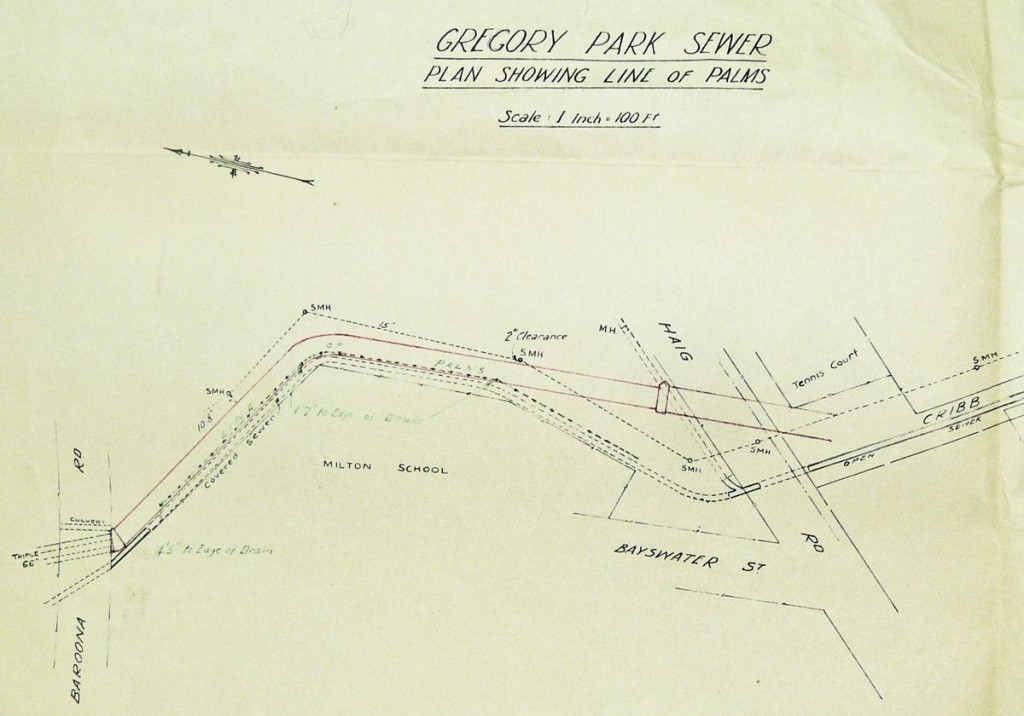
A sketch attached to a memo describing an estimate of a new covered drain through Gregory Park. (Brisbane City Council, Gregory Park, Brisbane – file relating to declaration of, 1928-1940. Brisbane City Council Archives.)
More detailed costings brought the cost estimate down to £11,369. Unfortunately, this is where the Brisbane Archives file on Gregory Park ends, so I don’t know when the work was done, or whether it was done as per the plans prepared in 1938.34 Whenever it happened, it marked an important milestone in the transformation of Gregory Park. Nearly fifty years after the first plans were drawn to drain Red Jacket Swamp, the park’s metamorphosis from swamp to mud hole to village green was all but complete. Now named, drained, raised and dressed, Gregory Park was ready to be fully embraced as Rosalie’s playground. But first, Gregory Park had one more duty to fulfil.
Gregory Park goes to War (1942 – 1945)
Following the bombing by the Japanese of Pearl Harbour on 7 December 1941, and then Darwin on 19 February 1942, Brisbane became a strategic headquarters for the Allied Forces as well as a potential bombing target. To prepare for a bomb attack, Brisbane (and many other cities across Australia) built hundreds of public air raid shelters, which in addition to brick and concrete bunkers included ‘slit trenches’ dug into parks and schoolyards. Gregory Park, having finally been drained, filled and covered, was about to be dug up again.
Knowing the history of Gregory Park, you would wonder how anyone would think that digging trenches in it was a good idea. Nevertheless, someone thought it was worth a try, and on 4 February 1942 the Courier Mail reported that
The Head Master and Committee of the Milton State School on digging 30ft of trial trench over the week-end and finding that the ground is reasonably suitable for same have decided to call for volunteer labour to assist them In digging the required amount of trenches.35
Within a month, however, the trenches had to be abandoned, and sandbags were adopted instead. As an article in the Courier Mail explained,
Sandbag shelters are necessary at Milton school, as it has been found impossible to keep water out of the trenches already provided. These trenches were dug in Gregory Park, which is filled-in land that once formed part of Red Jacket Swamp.36
When it came to building the sandbag trenches, Milton School parents were not very forthcoming. For a time the school remained closed because an insufficient number of trenches had been built, despite repeated appeals for volunteers from the school committee secretary, Mr E. T. Cramb. Eventually Mr Cramb announced that only those students whose parents had helped build trenches would be admitted to school, while others would be turned away until the trenches were built.
In September 1942, Gregory Park hosted Brisbane’s first competitive air raid display, watched by more than 1000 spectators. Highlights included a gas demonstration in which “several smoke bombs were set off”, and “the extinguishing of a fire by two local auxiliary fire units”. The competition, which included a barrage of tests catering to every kind of emergency, was won by Torwood, who defeated Milton 310 to 288 on account of their superiority in the gas demonstration.
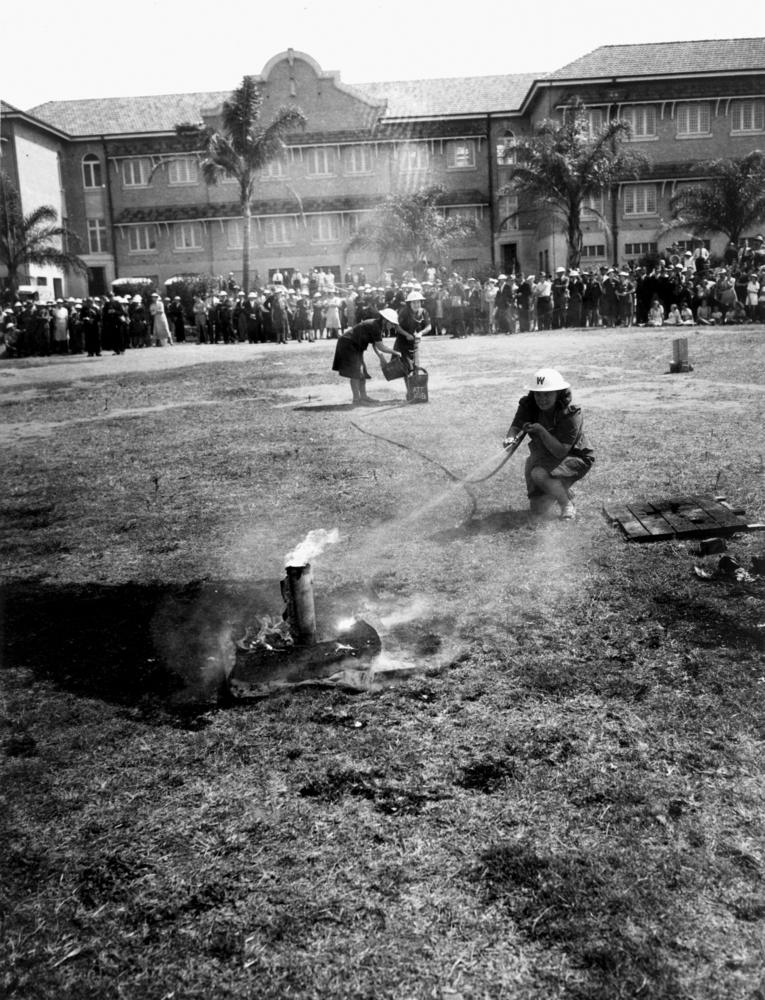
Fire fighting display outside Milton State School, ca. 1942. (John Oxley Library, State Library of Queensland Neg: 64527)
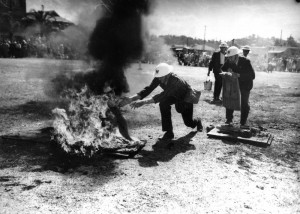
Wardens attacking an oil incendiary bomb with sand-mats during the Rosalie-Torwood inter-zone A.R.P.competition (description supplied with photograph). (John Oxley Library, State Library of Queensland Neg: 109837)
Next page
Page 1 – Page 2 – Page 3 – Page 4 – Page 5
Contents
Notes:
- The Brisbane Courier, 24 September 1906, p7. ↩
- The Brisbane Courier, 24 November 1906, p4. ↩
- The Brisbane Courier, 29 April 1907, p9. ↩
- The Brisbane Courier, 11 July 1906, p4. ↩
- The Brisbane Courier, 29 March 1922, p9. ↩
- The Brisbane Courier, 31 May 1909, p4. ↩
- The Brisbane Courier, 15 March 1910, p7. ↩
- The Brisbane Courier, 13 June 1910, p7. ↩
- The Brisbane Courier, 21 January 1911, p11. ↩
- The Brisbane Courier, 15 April 1911, p14. ↩
- The Brisbane Courier, 1 May 1911, p5. ↩
- The Brisbane Courier, 16 October 1915, p6. ↩
- Albert Neville Thiele, “Gregory Park: Reminiscences of Milton S.S.”, in Milton School Centenary Book, 1989, p50 ↩
- The Brisbane Courier, 12 November 1889, p3. The first Arbour Day in Australia was observed in Adelaide on 20 June 1889. ↩
- The Brisbane Courier, 4 June 1924, p5. ↩
- By this time it was actually called the Rosalie–Milton Improvement Association. ↩
- Brisbane City Council, Gregory Park, Brisbane – file relating to declaration of, 1928-1940. The file is held by the Brisbane Archives. ↩
- Buckberry, D. (ed.) 1999, Padd, Paddo, Paddington: An oral and visual history of early Paddington, Red Hill Paddington Community Centre, Paddington, Qld, p66. ↩
- The Brisbane Courier, 31 October 1925, p23. ↩
- Memo signed by William Jolly, 29 May 1926. In Brisbane City Council, Gregory Park, Brisbane – file relating to declaration of, 1928-1940. The file is held by the Brisbane Archives. ↩
- The Brisbane Courier, 1 November 1926, p11. ↩
- The Brisbane Courier, 31 May 1927, p9. ↩
- The Brisbane Courier, 2 May 1928, p16. ↩
- Brisbane City Council, Gregory Park, Brisbane – file relating to declaration of, 1928-1940. ↩
- Albert Neville Thiele, “Gregory Park: Reminiscences of Milton S.S.”, in Milton School Centenary Book, 1989, p50. ↩
- The Brisbane Courier, 29 August 1928, p10. ↩
- Brisbane City Council, Gregory Park, Brisbane – file relating to declaration of, 1928-1940. ↩
- Albert Neville Thiele, “Gregory Park: Reminiscences of Milton S.S.”, in Milton School Centenary Book, 1989, p50. ↩
- The Brisbane Courier, 29 May 1933, p12. ↩
- The Brisbane Courier, 7 April 1934, p7. ↩
- The Brisbane Courier, 7 April 1934, p7. ↩
- Brisbane City Council, Gregory Park, Brisbane – file relating to declaration of, 1928-1940. ↩
- Ibid. ↩
- Anyone want to check the Council minutes to find out!? ↩
- The Courier Mail, 4 February 1942, p9. ↩
- The Courier Mail, The Courier Mail, 3 March 1942, p4. ↩
Last modified: August 26, 2023

